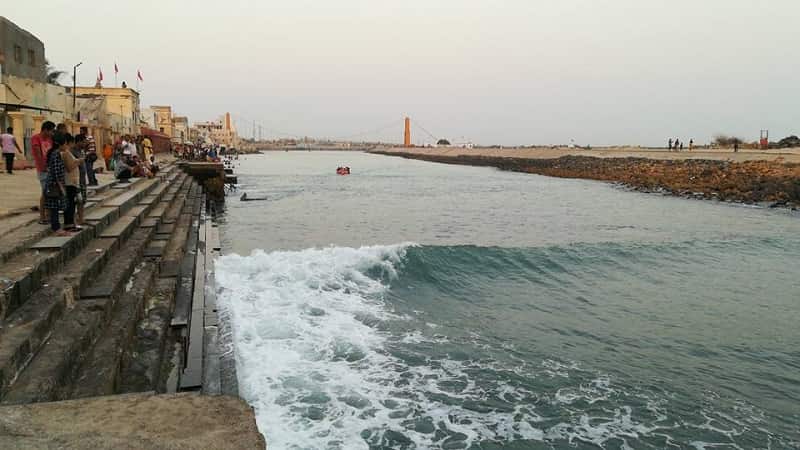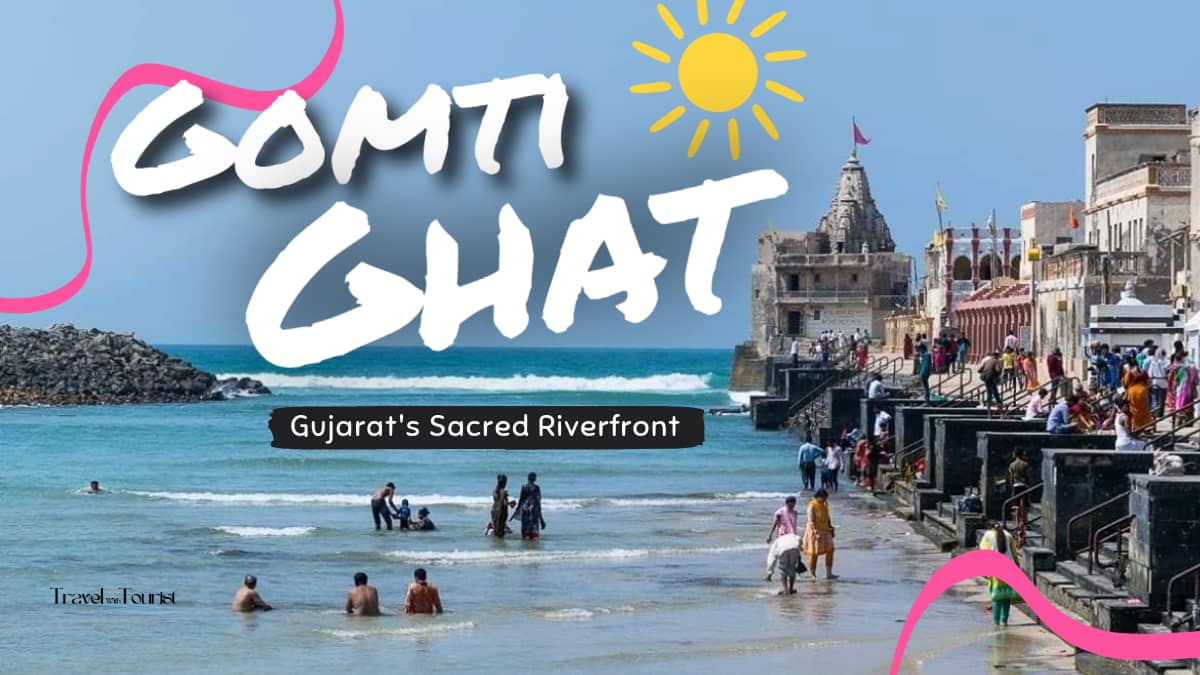Did you know that over 500,000 pilgrims visit Gomti Ghat in Dwarka every year, making it one of Gujarat’s most revered spiritual destinations?
I’ve walked these ancient steps myself, and let me tell you – there’s something absolutely magical about watching the sunrise over the Gomti River while temple bells echo across the water.
Nestled in the heart of Dwarka, one of Hinduism’s four sacred dhams, Gomti Ghat serves as a spiritual gateway where devotees have performed sacred rituals for centuries.
This isn’t just another tourist spot; it’s a living testament to India’s rich cultural heritage where ancient traditions meet the gentle flow of the sacred Gomti River.
Whether you’re planning your first pilgrimage or returning to reconnect with your spiritual roots, this comprehensive guide will help you navigate everything from sacred rituals to practical travel tips for visiting this extraordinary destination.
The Sacred History and Mythology of Gomti Ghat
The story of Gomti Ghat is deeply woven into the fabric of Hindu mythology and Lord Krishna’s divine leelas.
According to ancient texts, this sacred riverfront witnessed some of the most significant moments in Krishna’s earthly incarnation.
The Gomti River itself is considered sacred, believed to have originated from the foot of Lord Vishnu and blessed by Krishna’s divine presence during his reign in Dwarka.
Archaeological evidence suggests that the current ghat structure has been in continuous use for over 800 years, though the site’s spiritual significance dates back much further.
Ancient scriptures, including the Skanda Purana and Vishnu Purana, make numerous references to the sanctity of these waters and their power to cleanse devotees of their sins.
The Mahabharata describes how Krishna established Dwarka as his capital, choosing this location specifically for its spiritual energy and the presence of the sacred Gomti.
Local legends tell of how the river would change its course to accommodate Krishna’s divine activities, and even today, devotees believe that taking a holy dip here can wash away lifetimes of karmic burdens.
Historical records from various dynasties show continuous patronage and development of the ghat complex.
The Solanki rulers of Gujarat were particularly instrumental in expanding the facilities, while later rulers from different periods added their own architectural contributions, creating the harmonious blend of styles we see today.
Architectural Marvels and Sacred Structures at Gomti Ghat

Walking down to Gomti Ghat feels like stepping back in time through centuries of architectural evolution.
The main ghat structure showcases exquisite stone craftsmanship that has withstood countless monsoons and the test of time.
What strikes me most about the ghat’s design is how thoughtfully it accommodates the daily rituals of thousands of devotees.
Multiple levels of steps allow for different types of ceremonies to occur simultaneously, from simple ablutions to elaborate Pooja.
The architects clearly understood the spiritual needs of pilgrims and created spaces that enhance rather than hinder devotional practices.
Recent conservation efforts have been remarkable in preserving the original character while adding necessary modern amenities.
The Archaeological Survey of India has worked closely with local authorities to ensure that any restoration work maintains historical authenticity while improving safety and accessibility for visitors.
Religious Rituals and Spiritual Practices
The spiritual heart of Gomti Ghat beats strongest during the early morning hours when devotees gather for their sacred bath rituals.
The practice of taking a holy dip in the Gomti River is believed to purify both body and soul, preparing devotees for deeper spiritual practices and temple visits.
Dwarka Main Temple Daily aarti ceremonies begin before sunrise, usually around 5:30 AM, when the gentle light creates a mystical atmosphere over the water. I recommend arriving at least 30 minutes early to find a good viewing spot and soak in the peaceful ceremony ambiance.
Pitra paksha rituals hold special significance at Gomti Ghat, with families traveling from across India to perform ancestral worship ceremonies.
During this period, usually falling in September-October, the ghat becomes a hub of activity as priests guide families through elaborate rituals aimed at bringing peace to departed souls.
The sight of hundreds of diyas floating on the river during these ceremonies is truly unforgettable.
Many couples choose Gomti Ghat for pre-wedding ceremonies, particularly the sacred thread ceremony for grooms.
The combination of Krishna’s blessings and the purifying waters makes this location especially auspicious for life’s important transitions.
Local priests are well-versed in conducting these ceremonies and can guide families through the proper protocols.
For those seeking personal spiritual practice, the early morning hours offer perfect conditions for meditation and yoga along the riverbank.
The natural sounds of flowing water combined with distant temple bells create an ideal backdrop for inner contemplation and spiritual reflection.
Festivals and Celebrations at Gomti Ghat
Janmashtami transforms Gomti Ghat into a spectacular celebration of Krishna’s birth, with elaborate decorations, continuous kirtans, and thousands of devotees participating in midnight festivities.
The entire ghat complex sparkles with lights, flowers, and colorful rangoli designs that create a truly divine atmosphere.
Special arrangements include additional security, extended aarti timings, and organized cultural programs that continue well into the night.
Kartik Purnima brings another wave of spiritual energy to the ghat, as this full moon day is considered especially auspicious for holy baths and spiritual practices.
Devotees believe that prayers offered during Kartik Purnima carry extra spiritual merit, making this one of the busiest periods at the ghat.
The sight of thousands of oil lamps floating on the Gomti River during this festival creates a mesmerizing spectacle.
Local Gujarat festivals add unique flavors to the ghat’s celebration calendar.
Diwali brings special lighting displays that illuminate the entire riverfront.
Each festival offers visitors a chance to experience authentic Gujarati culture alongside spiritual practices.
The monsoon season brings its own spiritual significance, with devotees believing that bathing in the rain-swollen Gomti River during Shravan month carries special blessings.
Though the ghat can become crowded during these peak times, the energy and devotion of fellow pilgrims create an atmosphere that’s both humbling and inspiring.
Participating respectfully in these celebrations requires understanding local customs and following the guidance of experienced devotees or priests.
Don’t hesitate to ask questions – local people are generally happy to share their knowledge and help visitors participate meaningfully in the festivities.
Best Time to Visit and Travel Planning
Planning your visit to Gomti Ghat requires careful consideration of both spiritual and practical factors.
The winter months from November to February offer the most comfortable weather conditions, with pleasant temperatures that make spending extended time at the ghat enjoyable.
This period also coincides with several important festivals, providing rich cultural experiences alongside comfortable weather.
The monsoon season from June to September brings its own spiritual significance, though practical challenges like heavy rains and flooding can affect access.
If you’re comfortable with these conditions, monsoon visits offer a more intimate experience with fewer crowds and the unique beauty of rain-refreshed stone architecture.
Summer months can be quite challenging due to Gujarat’s intense heat, but early morning visits remain pleasant and spiritually rewarding.
If you visit during summer, plan your ghat activities for sunrise and late evening hours, avoiding the harsh midday sun.
Peak pilgrimage seasons around major festivals mean larger crowds but also more elaborate celebrations and cultural programs.
Book accommodation well in advance during these periods, and be prepared for longer wait times at popular spots.
The energy during peak seasons is incredible, but if you prefer quieter spiritual experiences, consider visiting during off-peak times.
Budget-conscious travelers will find that off-season visits offer better hotel rates and more negotiating power with local vendors.
Some shops and services may have reduced hours during slower periods, so plan accordingly.
Nearby Attractions and Temple Circuit
The crown jewel near Gomti Ghat is undoubtedly the magnificent Dwarkadhish Temple, located just a short walk away.
This architectural masterpiece houses the primary Krishna deity and serves as the spiritual center of Dwarka.
Plan to spend at least 2-3 hours here, allowing time for darshan, circumambulation, and quiet contemplation in the temple’s peaceful courtyards.
Bet Dwarka, accessible by boat from Okha port (about 30 km from Dwarka), offers an incredible day trip opportunity.
This island is believed to be Krishna’s original residence, and the boat journey itself provides beautiful views of the Arabian Sea.
The island temples are less crowded than mainland attractions, offering more intimate spiritual experiences.
Nageshwar Jyotirlinga Temple, one of the twelve sacred Shiva shrines, sits just 17 km from Gomti Ghat.
This creates an excellent opportunity to seek blessings from both Krishna and Shiva during your pilgrimage.
The temple’s towering Shiva statue is visible from miles away and makes for impressive photographs.
Local markets around Gomti Ghat offer authentic Gujarati handicrafts, religious items, and local delicacies. The street food here is exceptional – try the local dhokla, khandvi, and various sweets that are prepared fresh daily.
These markets also provide excellent opportunities to purchase religious items and souvenirs that carry the spiritual energy of your pilgrimage.
Heritage walks organized by local guides can provide deeper insights into Dwarka’s history and hidden spiritual spots that many visitors miss.
These tours typically last 2-3 hours and cover both well-known and lesser-known temples, along with stories and legends that bring the ancient city to life.
Practical Visitor Information and Facilities
Getting to Gomti Ghat is relatively straightforward, with Dwarka well-connected by road and rail to major Indian cities.
The nearest airport is in Jamnagar, about 137 km away, while Dwarka Railway Station is just 2 km from the ghat.
State transport buses and private vehicles provide regular connectivity, though I recommend booking transportation in advance during peak seasons.
Accommodation options range from budget dharamshalas to comfortable hotels, with many located within walking distance of Gomti Ghat.
Budget travelers can find clean, basic rooms in dharamshalas starting from ₹200-500 per night, while mid-range hotels offer better amenities for ₹1500-3000 per night.
Luxury options are limited but available for those seeking premium comfort.
Safety at Gomti Ghat is generally good, with regular police patrolling and CCTV coverage in main areas.
Exercise normal precautions with valuables and be careful on wet stone steps, especially during early morning or evening hours when lighting may be limited.
Families with young children should supervise them closely near the water.
The ghat complex offers decent accessibility features for elderly and disabled visitors, including ramps at some locations and assistance from local volunteers.
The traditional stone steps remain the primary access method, so visitors with mobility challenges should plan accordingly and consider bringing assistive devices.
Emergency medical facilities are available at the nearby government hospital, and several private clinics operate in Dwarka city.
Keep important phone numbers handy, including local police (100), medical emergency (108), and tourist helpline numbers provided by Gujarat Tourism.
Cultural Etiquette and Respectful Tourism
Visiting sacred sites like Gomti Ghat requires sensitivity to local customs and religious practices.
Modest dress is essential – men should wear long pants and shirts with sleeves, while women should choose conservative clothing that covers legs and shoulders.
Many devotees appreciate visitors who make an effort to dress respectfully, and it often leads to more welcoming interactions.
Photography guidelines can be complex at religious sites.
While general ghat photography is usually permitted, avoid photographing people during personal prayers or ceremonies without permission.
Some areas may have specific restrictions, so always ask local priests or security personnel when in doubt.
Remember that flash photography can be disruptive during spiritual practices.
Interaction with local priests and devotees should be respectful and humble.
Many priests speak basic English and are happy to explain rituals or answer questions about the site’s significance.
A small donation (dakshina) is customary when receiving blessings or guidance from priests, though the amount is entirely at your discretion.
Environmental conservation has become increasingly important at sacred sites.
Carry reusable water bottles, dispose of waste properly, and avoid using plastic items that might end up in the sacred river.
Many local initiatives promote eco-friendly pilgrimage practices, and your participation helps preserve these sites for future generations.
Supporting local communities through responsible tourism makes a real difference.
Choose local guides, eat at family-run restaurants, and purchase souvenirs from small vendors when possible.
These choices help ensure that tourism benefits reach the people who maintain and protect these sacred spaces.
Conclusion
Gomti Ghat in Dwarka offers more than just a spiritual experience – it’s a journey into the heart of India’s ancient wisdom. Whether you’re seeking divine blessings, cultural enrichment, or simply a moment of peace by the sacred waters, this remarkable destination delivers on every level.
The combination of breathtaking architecture, profound spiritual significance, and living cultural traditions creates an experience that stays with you long after you’ve returned home. I’ve witnessed countless visitors describe their time at Gomti Ghat as transformative, speaking of inner peace found and spiritual questions answered in ways they never expected.
Planning your visit requires thoughtful consideration of timing, cultural respect, and spiritual preparation. I encourage you to approach Gomti Ghat not just as tourists, but as humble seekers ready to embrace the profound spirituality that has drawn millions to these sacred shores. Take time to participate in rituals, engage with local devotees, and allow yourself to be open to whatever spiritual experiences may unfold.
The memories you create here – watching sunrise paint the ancient stones golden, hearing temple bells echo across the water, feeling the cool touch of sacred waters – will become treasured parts of your spiritual journey. Every moment spent in genuine reverence and cultural appreciation adds to the collective spiritual energy that makes places like Gomti Ghat so special.
Ready to embark on your spiritual journey? Start planning your pilgrimage to Gomti Ghat today and prepare to be transformed by one of Gujarat’s most sacred destinations!



